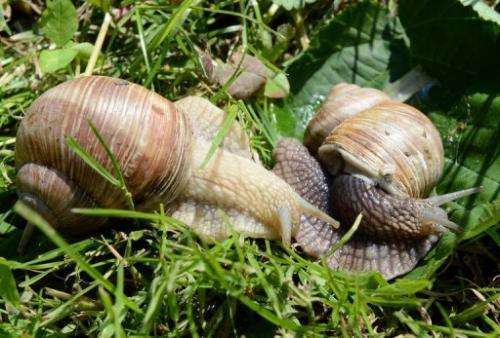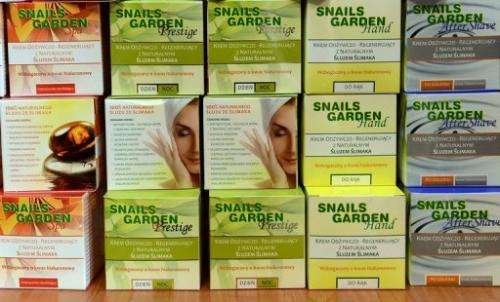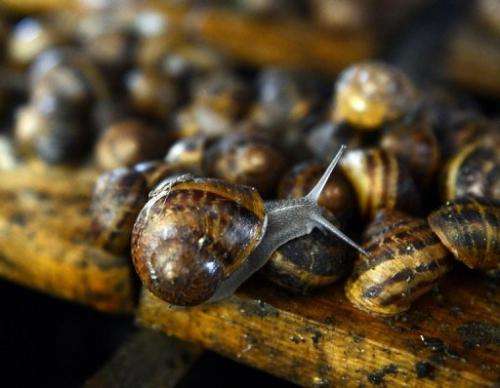Polish snail farms inch towards huge potential

At a snail farm in lake-rich northern Poland, one of a growing number of breeders across the country, it is easy to accidentally step on a mollusc making a break for freedom.
"You have to secure the area to stop the snails from fleeing, because they're very clever about it," said Mariola Pilat, 35, president of Snails Garden in the village of Krasin.
"They always find a hole to sneak through, always," she told AFP, adding that a snail's pace is surprisingly quick.
Despite the fugitives, snail farming—mostly for gastronomic ends—has advantages over traditional livestock farming, says farm owner Grzegorz Skalmowski, 42, whose office is in a snail-shaped cottage.
He points to the minimal investment and land required as one reason for the gradually growing interest in the niche business of breeding the black-toothed, rain-loving hermaphrodite.
"When I started a decade ago there were three breeders, now it's 300," he said, adding that most of them are just starting out.
An industry heavyweight, Skalmowski breeds up to 50 tonnes of snails a year—or five million individual gastropods—on the farm, making for an impressive snail-to-human ratio in the village of a couple of hundred people.
He also trains other people around the country and abroad to breed two kinds of Helix aspersa garden snails for him—the small grey Muller and large grey Maxima—bringing in an extra 40 tonnes a year.
Most of the 90 tonnes of snails produced are exported to Spain, Italy and France.

The farm sells the majority of the snails live—before the inevitable deadly toss into boiling water—but also offers canned meat, pearly white snail's egg caviar and, not for the faint-hearted, slime facial cream.
While still a small branch of the overall animal farming industry, snail breeding has a lot of potential for further development in Poland, industry sources say.
"When it comes to other animals, like cattle, pigs, poultry, there is huge competition here," said Maciej Ligaszewski from the National Research Institute of Animal Production.
But snail breeding "is still something new and original" in Poland, which sends most of its slimy molluscs to France to be swathed in garlic butter and served out of their spiralled shells.
France imports 95 percent of its snail consumption, of which nine percent comes from Poland, according to trade figures from the Polish embassy in Paris.

Poland is one of many exporters in an industry spread wide from Turkey to Hungary to Indonesia, but its share of the market is growing, the embassy said.
In 2011, Poland exported 282 tonnes of snails worth close to 1.1 million euros ($1.5 million), according to the Central Statistical Office.
Poland has been shipping snails to France for decades, but the wild kind: Helix pomatia or "winniczek" in Polish, also known as the famous Burgundy snail after the French region.
"The French escargot, there's almost none left, for a simple reason: pesticides," said Jacques Pommier, 84, organiser of an annual snail-guzzling festival in France.
"That's why they found snails in Eastern Europe that are exactly like the Burgundy escargot."
The vineyard snail is protected today in Poland: it can only be picked from late April to the end of May in certain areas and amounts, and at a minimum length of three centimetres (1.2 inches).
This puts gatherers at the weather's mercy, said Snails Garden employee Tomasz Kuchta, 36, as he traipsed around a field in rain boots, clutching a bucket whose contents were crawling towards the rim.

"They can probably sense they're headed for the dinner table," Kuchta joked, adding that the shy mollusc famous for retreating into its shell likes its personal space and scales the sides to escape the crowd.
While Poland's snail farming is majority export, the tiny creature with a flavour akin to mushroom or chicken was once a fixture of the Polish kitchen.
"Poland's first cookbook (from 1682) has a handful of snail recipes, and—this is interesting—more than the number devoted to pork," said food historian Jaroslaw Dumanowski.
"The end of snail-eating and a general collapse of Polish cuisine came about after World War II" given the poverty and communist disdain for anything rich or fancy, he told AFP.
But with today's higher standard of living, Dumanowski says snails are making a comeback on menus and supermarket shelves, if still inching their way into home cooking.
Hoping for a revival of demand at home, farmer Skalmowski notes that today's dinner table is no stranger to more unusual dishes.
"We eat 'flaki' or beef tripe stew, no? And we also have 'czernina' (soup made from animal blood) right? Which for others is gross. But we eat it," he said.
Pilat chimed in: "And we make 'pierogi' dumplings with pig lungs. Those are our goodies."
At an event this month, the pair hope to entice locals with escargot a la polonaise: pierogi stuffed with snail.
© 2013 AFP


















